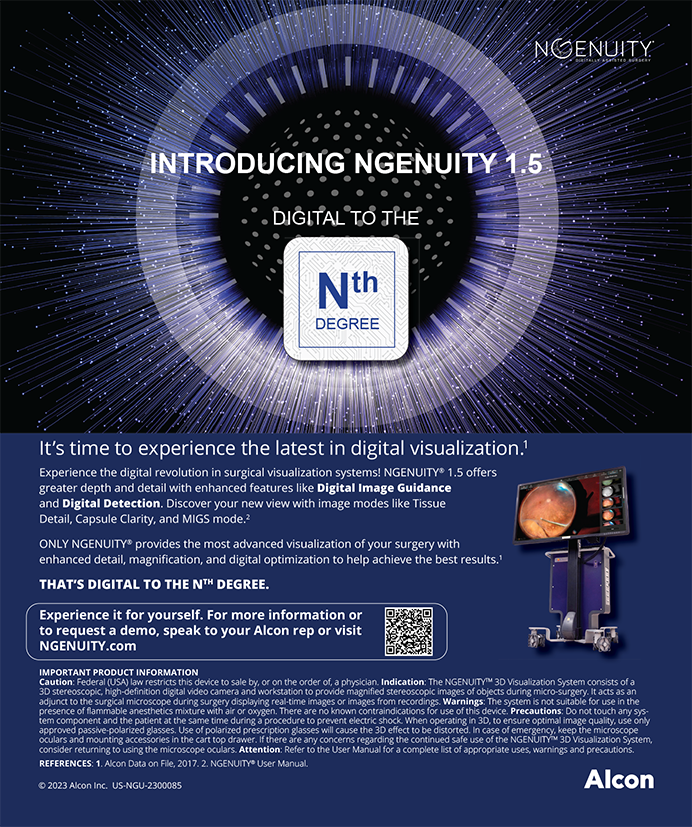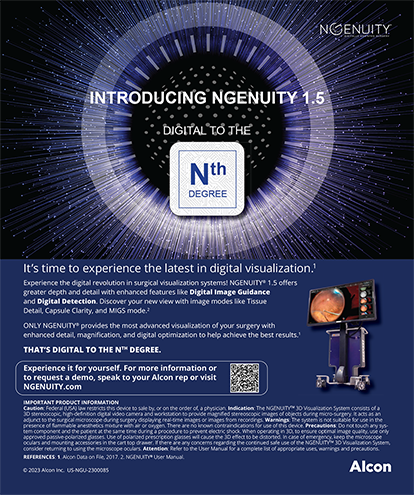Femtosecond lasers have demonstrated the ability to optimize the critical steps of cataract surgery (corneal incision, capsulotomy, and nuclear disassembly; www. optimedica.com/catalys-overview/clinical-videos).1-3 During the past 4 years, I have had the opportunity to use OptiMedica Corporation's Catalys Precision Laser System to create accurate, reproducible, and customized corneal and lenticular incisions (corneal incisions not FDA approved). In my experience, the laser procedure facilitates the subsequent intraocular steps of cataract surgery and reduces OR time, but some modifications to my surgical technique have been necessary.
CAPSULORHEXIS
Femtosecond lasers create a precisely sized, shaped, and centered capsulotomy, and the resected capsular disc is usually free-floating. When it is free of attachments, I proceed directly to hydrodissection (discussed later) without filling the anterior chamber with an ophthalmic viscosurgical device. If I am uncertain whether adhesions are present, however, then I do inject an ophthalmic viscosurgical device into the anterior chamber, which partially or completely elevates the capsular disc off the lens' surface to improve my visualization of the free edge. If the disc is not free-floating after this maneuver, I grasp it with capsule forceps and remove the disc with a circular motion similar to my manual capsulorhexis technique. My goal is to break any “postage stamp” adhesions or uncut area (a rarity), which could cause a radial tear.
HYDRODISSECTION
Prior to injecting fluid, I gently rock the lens to allow the cavitation bubbles to escape so that capsular block does not occur. This complication has not yet been observed in more than 400 cases performed with the Catalys, but its potential exists. I have found that less hydrodissection is required because of the partial pneumodissection produced by the gas bubbles.
PHACOEMULSIFICATION
Laser pretreatment of the lens facilitates nuclear disassembly by creating exact cleavage planes. I find it easy to separate the quadrants with minimal manual manipulation, and they can be evacuated as small “aspiratable” cubes (if a lens-softening pattern is applied) with less ultrasound energy than required for my traditional manual cataract procedure. On postoperative day 1, I have noticed that eyes treated with the laser are noticeably quieter and the corneas are much clearer.
CORTICAL REMOVAL
The capsulotomy cut creates a smooth circular edge of cortex that I can easily grasp with the I/A tip directly under the capsulotomy instead of having to search deep in the bag recess for cortical strands. In my experience, this also simplifies the removal of subincisional cortex.
IMPLANTATION OF THE IOL
The precisely sized and shaped capsulotomy facilitates the IOL's insertion. The centered capsulotomy helps me to position the lens and ensures complete capsular overlap of the optic's edge. In addition, the stronger lasercreated capsulotomy may be more resistant to tearing during manipulation of the IOL.3
CONCLUSION
I am amazed by femtosecond lasers' ability to produce a perfect capsulotomy with less deviation in effective lens position for any IOL design. Also remarkable is the reduction in ultrasound energy and intraocular manipulations made possible by the laser's precutting of the lens. Refinements in surgical technique will help ophthalmologists to take advantage of this wonderful technology.
Neil J. Friedman, MD, is a partner at Mid- Peninsula Ophthalmology Medical Group in Palo Alto, California; director of cataract and lens surgery at Pacific Vision Institute in San Francisco; and an adjunct clinical associate professor of ophthalmology at the Stanford University School of Medicine in Stanford, California. He is a consultant to and advisory board member of OptiMedica Corporation. Dr. Friedman may be reached at (650) 324- 0056; njfmd@pol.net.
- Palanker DV, Blumenkranz MS, Andersen D, et al. Femtosecond laser-assisted cataract surgery with integrated optical coherence tomography. Sci Transl Med. 2010;2(58):58ra85.
- He L, Sheehy K, Culbertson W. Femtosecond laser-assisted cataract surgery. Curr Opin Ophthalmol. 2011;22(1):43-52.
- Friedman NJ, Palanker DV, Schuele G, et al. Femtosecond laser capsulotomy. J Cataract Refract Surg. 2011;37:1189-1198.


